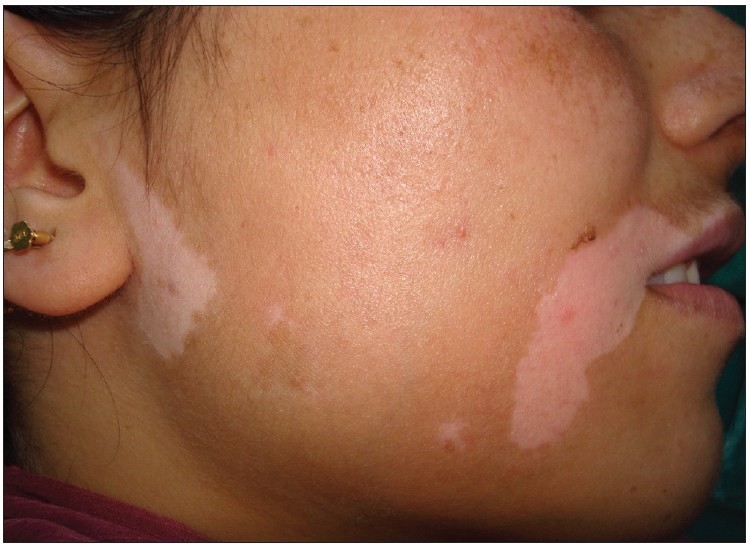Playlist
Show Playlist
Hide Playlist
Vitiligo in Darker Skin: Diagnosis and Management
-
Slides Vitiligo in Darker Skin Diagnosis Management.pdf
-
Download Lecture Overview
00:01 So how do we diagnose vitiligo? It's a clinical diagnosis. 00:05 However, we can use Wood's lamp, which actually accentuates the hypo or depigmented areas and they appear white. 00:14 And this is important because one can confuse vitiligo with other conditions, which we'll talk about when we look at the differential. 00:21 When you're not sure, a biopsy may be recommended. 00:26 So what can we confuse vitiligo with. 00:29 Basically what's the differential diagnosis of vitiligo. 00:32 Pityriasis alba meaning scaly, alba white. 00:36 This is mild skin condition that affects children and presents as hypopigmented patches on sun exposed areas. We'll talk about this later in our lectures. 00:47 A tinea or pityriasis versicolor is another differential, but we know that this is a yeast infection that causes loss of pigment. 00:55 Because the yeast Malassezia furfur produces a pigment or an enzyme called azelaic acid, which then causes depigmentation of the skin, and these may present as pale macules on the upper trunk and chest. Chemical leukoderma is another differential for vitiligo. 01:14 And here we have depigmentation at the contact area between the chemical and the skin. 01:21 And this can spread due to certain chemicals such as hydroquinone and paraphenylenediamine, which is something that we find in hair dyes. 01:31 Paraphenylenediamine is found in hair dyes . 01:36 Off note recently we know there's been Covid in the last couple of years. 01:40 We have seen patients presenting with leukoderma due to the Covid virus, so there seems to be a potential link between the vaccine and the development of hypopigmented skin lesions. So lastly, we want to talk about the management of vitiligo. 01:57 It is important that all patients should practice sun avoidance and protection. 02:02 Because the depigmented areas become very sensitive to the sun. 02:07 They can become red and rarely we have actually described a case of skin cancer occurring in a patient with vitiligo, although it's not that common. 02:17 Thyroid function testing should be performed due to the strong association with thyroid disease, as mentioned in our pathogenesis, and we know that this presents in about 14 to 34% of vitiligo patients. A stable vitiligo, how do we define a stable vitiligo? It is when there are no new lesions and no progression of existing lesions for at least two years. So we can label that as a stable vitiligo. 02:45 And what is unstable vitiligo. 02:47 New lesions are appearing. 02:49 There is progression of existing lesions over the past six weeks. 02:53 So that tells us that the vitiligo is active. 02:57 So these are the forms of treatments that we use for vitiligo. 03:02 Topical corticosteroids are good for localized disease. 03:06 But again as it is with other diseases, when you use topical corticosteroids you have to be careful of the risk of skin atrophy, which is thinning of the skin. 03:17 Some side effects include burning sensation in treated areas. 03:22 The second form of treatment is the use of calcineurin inhibitors, and the following are listed over there. 03:31 And this is an alternative to topical steroids as it has a minimal side effects in terms of skin thinning. This is also preferred in areas at high risk of skin atrophy. 03:43 For example, the skin, genitals, and intertriginous regions. 03:47 The side effects of topical calcitriol inhibitors include burning or stinging of the skin, particularly in the first week or so of using the cream. 03:56 So it's important that we warn the patients, otherwise they will stop the treatment. 04:00 Systemic glucocorticoids we can use these as oral or intramuscular. 04:05 And it's the first line therapy for stabilization of rapidly progressive disease. 04:09 We've mentioned what we mean by progressive disease. 04:13 So those are the signs and symptoms that we'll be looking for. 04:16 The side effects include skin thinning, ecchymosis, acne, hirsutism, and facial erythema. 04:23 And of course, if you lose it for a long time, one can even develop osteoporosis and diabetes mellitus. Systemic immunosuppressants also have been used. 04:34 The following have been used like methotrexate, mycophenolate, and cyclosporin, and these are an alternative to systemic steroids, which needs close monitoring and avoid more side effects. 04:46 And what's listed there are some of the side effects of systemic immunosuppressants. 04:53 Phototherapy is often used in conjunction with medical therapy, but this means a patient may have to come twice or three times a week. 05:02 So we need to make sure that the patient has access to these. 05:06 Phototherapy can be used alone for stabilizing the disease or for rapidly progressive disease if steroids are contraindicated. 05:15 As mentioned, the frequency of clinic attendance is 2 to 3 times. 05:21 When do we use the option of depigmentation therapy? This we use as an option for extensive disease involving more than 40% of body surface area, and it's used on areas of unaffected skin. 05:36 And the main goal is to make sure that we match the diseased area for cosmetic satisfaction and for the aesthetic appearance, instead of having an irregular hypo and hyperpigmented patches on the skin. 05:51 Amongst the treatments that we also use for vitiligo, there's also surgical transplantation procedures and the techniques used are skin grafts, punch grafts and sometimes autologous melanocyte cultures. 06:08 These may be used for stable, localized lesions as described earlier in our lecture.
About the Lecture
The lecture Vitiligo in Darker Skin: Diagnosis and Management by Ncoza Dlova is from the course Hyper- and Hypopigmentation Skin Disorders.
Included Quiz Questions
How long must a patient have no new lesions or progression of existing lesions to be classified as having stable vitiligo?
- At least 2 years
- At least 6 weeks
- At least 6 months
- At least 1 year
- At least 3 years
Which diagnostic tool is used to accentuate hypopigmented areas in vitiligo?
- Wood's lamp
- Dermoscopy
- Skin scraping
- Direct microscopy
- UV photography
When is depigmentation therapy indicated in vitiligo management?
- When more than 40% of body surface area is affected
- When less than 20% of body surface area is affected
- When the disease is localized to the face
- When the disease is stable for 6 months
- When phototherapy has failed
What percentage of vitiligo patients should be monitored for thyroid disease?
- 14-34%
- 2-9%
- 42-52%
- 54-74%
- 82-95%
Customer reviews
5,0 of 5 stars
| 5 Stars |
|
5 |
| 4 Stars |
|
0 |
| 3 Stars |
|
0 |
| 2 Stars |
|
0 |
| 1 Star |
|
0 |




